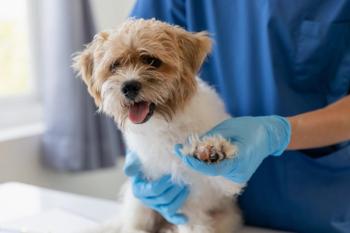
More than rehabilitation: A conversation with a free-ranging wildlife veterinarian
Deck: This targeted position manages disease at the wildlife population level, keeping its health and safety at the forefront.
Editors' note: In our
Drew in the field with a moose.
When Mark Drew, DVM, MS, DACZM, a veterinarian for the Idaho Department of Fish and Game, graduated from veterinary school at the University of Minnesota in 1987, the path to practice in free-ranging wildlife management was much different from what it is today.
“Prior to 1980 there were only three free-ranging wildlife veterinarians in the country that were working for wildlife management agencies. Now there are about 40,” Drew says. “I started with an undergraduate degree in wildlife management and a master's degree in zoology before I went to veterinary school. There weren't the same opportunities for internships that there are now, because they just didn't exist yet.”
Primary functions of a free-ranging wildlife management veterinarian
Under the general context of wildlife health and management, a big part of Drew's primary responsibilities is disease surveillance and taking biological samples to monitor the presence or absence of disease or changes in existing disease in wildlife populations. Some of this surveillance data is from live animals and some is from animals found dead. Conducting necropsies on animals found dead by the public or agency personnel is an important component of the job. Then he applies this disease information to wildlife population management and works with wildlife biologist in the agency to understand and monitor how a disease may affect the wildlife populations.
As the veterinarian on staff for the Idaho Department of Fish and Game, Drew is also in charge of the controlled substances used in the agency. He also works with captive wildlife permit applications, importation and exportation of wildlife, report writing, and dissemination of information about diseases of concern in wildlife. He occasionally provides information on wildlife health and disease issues for the state legislature or other state agencies.
Because the position deals with disease on a population level as well as those of an individual animal, the specialized skills needed for a job in the field are far-ranging. “Since we're a wildlife management agency there needs to be a basic understanding of wildlife population management-things like resource management, ecology and natural resources,” Drew says.
There are two national associations-The
Drew in the field.
Though internship and residency programs have come a long way, Drew believes there's still a ways to go regarding the education veterinarians interested in wildlife medicine would need in the veterinary school curriculum. “We deal with students who are interested in coming out and seeing what wildlife veterinary medicine is like in a two-week externship, but there's nothing built into the curriculum that provides the background for these students,” Drew says. “They may have an exotic animal track, but nothing that looks at the population level, which is what we typically do. There are things that apply, like pathology and epidemiology, and all the basic veterinary skills, but there needs to be something that connects students to wildlife management because that's what the agency does.”
Drew worked at a mixed animal mixed practice in Wisconsin for a few years before moving on to a residency in Zoo and Wildlife Medicine. “I needed to learn to be a veterinarian first, but wildlife veterinary medicine had always been in the back of my mind. My undergraduate mentor, Dan Trainer, was one of the fathers of wildlife disease for wildlife managers and veterinarians,” he says. Dr. Trainer planted the seed for the combination of a wildlife management degree and a veterinary medicine degree with the idea of working as a veterinarian in wildlife disease for a management agency.
The job pool in the free-ranging wildlife veterinary field is small-currently there are about 40 in the United States and Canada-but if there was one veterinarian on staff in each state and province, there would be about 60, Drew says. So there would be room to grow if the states and provinces created more positions, he says. But there are also wildlife veterinary opportunities in the U.S. Department of Agriculture, the U.S. Fish and Wildlife Service, the National Park Service, the U.S. Forest Service, tribal governments, and the military. International opportunities also exist through various governmental agencies or non-governmental organizations.
Education is another aspect of free-ranging wildlife veterinary positions. “Diseases that occur in wildlife or which wildlife can act as a reservoir may have human implications-like tuberculosis, plague, rabies and other zoonoses-we work with the Department of Human Health to communicate to the public and physicians about the relative risks of these diseases in various wildlife species and how to avoid exposure,” Drew says.
Drew with a bison.
The same principles apply with risks to domestic animal herds, like cattle, and wildlife. For example, in Idaho where Drew is, some elk are infected with Brucella abortus, which can be transmitted to cattle. “We work with and communicate with the Idaho Department of Agriculture and livestock owners to minimize the risk to their herds and we also have to manage the elk populations with the same goal,” Drew says.
Another component of education is to manage inquiries from hunters and trappers who contact Drew when they find something that seems out of the ordinary. “We try to educate and inform the hunting and trapping public to identify various pathogens in the animals that they have harvested and to provide advice on how to avoid exposure to these pathogens to minimize the risk to themselves, their pets and livestock.
Newsletter
From exam room tips to practice management insights, get trusted veterinary news delivered straight to your inbox—subscribe to dvm360.




